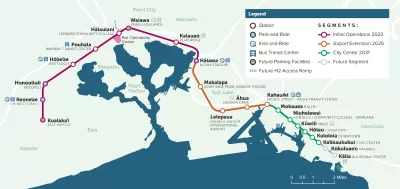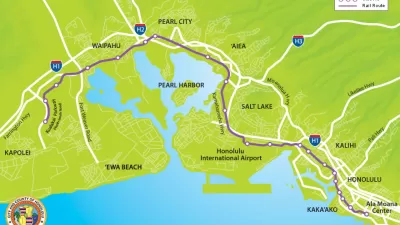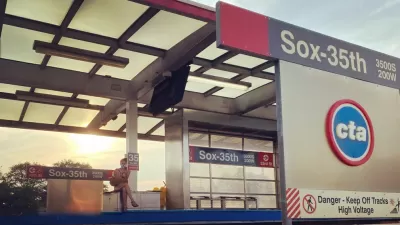In a historic day for public transit, Skyline Rail, a project once deemed the worst transit project in the United States due to extreme cost overruns and construction delays, finally opened to the public at the end of June.

The Honolulu Rail Transit Project, now named Skyline Rail, opened to the public on Friday, June 30, culminating a half century of planning and overcoming serious obstacles with delays and funding shortfalls in the final years.
Honolulu’s new rail service “seemed a near impossibility just 2-1/2 years ago when it was digging a deeper financial hole and federal transit officials had lost faith and were withholding millions of dollars in badly needed funding,” reports Dan Nakaso in a paywalled article for the Star Advertiser.
The opening is just the first phase of a $9.8 billion plan. Nakaso’s article focuses mostly on how the Honolulu Authority for Rapid Transportation and city leadership overcame funding obstacles to get this first leg of the project open, including adopting a new county hotel tax aimed at tourists, approved by the State Legislature, and reducing the scope of the project. A 2012 iteration of the plan called for the entire project to span 20 miles and include 21 stations, from East Kapolei to Ala Moana Center. The current plan will build 19 stations and 18.75 miles of track, ending in Kakaako at the Civic Center Station, or Ka‘akaukukui.
The paywalled article, linked again below, also offers more guidance on the how to use the system, including info about parking (there is only limited parking available at three of the new stations). According to a separate article by Hawaii News Now, 9,000 people rode Skyline on its first day of service to the public.
FULL STORY: Honolulu’s Skyline is ready to roll

Manufactured Crisis: Losing the Nation’s Largest Source of Unsubsidized Affordable Housing
Manufactured housing communities have long been an affordable housing option for millions of people living in the U.S., but that affordability is disappearing rapidly. How did we get here?

Americans May Be Stuck — But Why?
Americans are moving a lot less than they once did, and that is a problem. While Yoni Applebaum, in his highly-publicized article Stuck, gets the reasons badly wrong, it's still important to ask: why are we moving so much less than before?

Research Shows More Roads = More Driving
A national study shows, once again, that increasing road supply induces additional vehicle travel, particularly over the long run.

Gary, Indiana to Expand Transit Service, Bike Share
The city plans to launch a bike share system in April and expand service on its bus routes.

Pittsburgh Rolls Out Electric School Buses
Pittsburgh Public Schools has launched its first electric school buses, with plans to fully electrify its fleet over the next 14 months, aiming to create a cleaner, more sustainable transportation system supported by new charging infrastructure.

Concrete to Community: A Schoolyard Makeover in West Philly
With guidance from the Trust for Public Land, third graders at Overbrook Elementary are leading the redesign of their asphalt schoolyard into a vibrant green space, learning valuable skills and creating lasting community impact in the process.
Urban Design for Planners 1: Software Tools
This six-course series explores essential urban design concepts using open source software and equips planners with the tools they need to participate fully in the urban design process.
Planning for Universal Design
Learn the tools for implementing Universal Design in planning regulations.
City of Moreno Valley
Institute for Housing and Urban Development Studies (IHS)
City of Grandview
Harvard GSD Executive Education
NYU Wagner Graduate School of Public Service
City of Cambridge, Maryland
Newport County Development Council: Connect Greater Newport





























